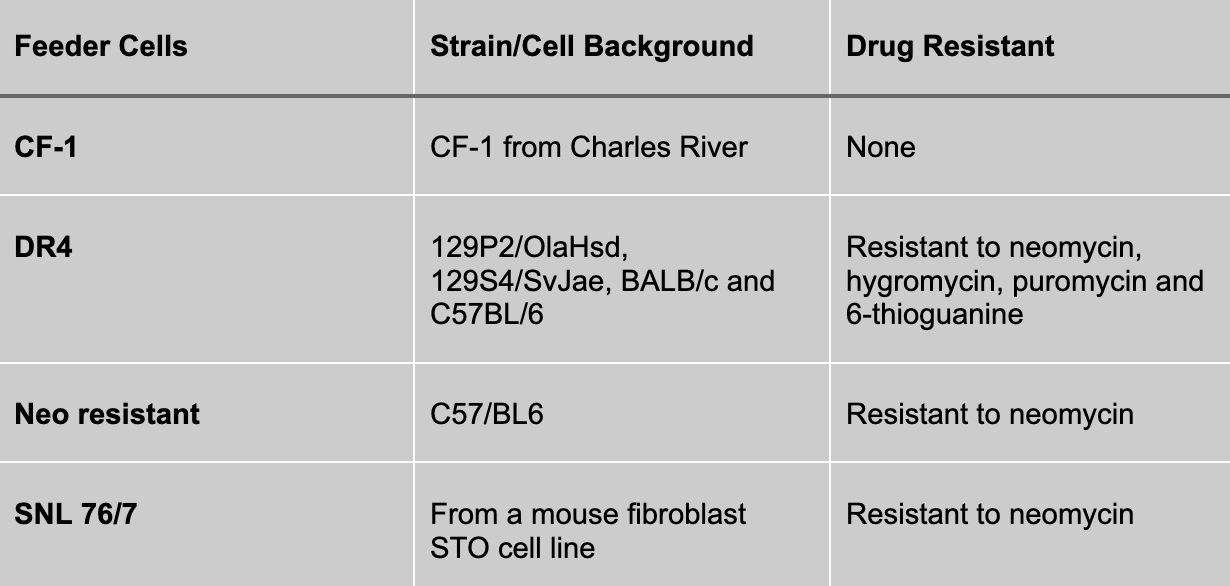MEF Feeder Cells
Applied StemCells support your advanced research needs by providing all of the high-quality Mouse Embryonic Fibroblast (MEF) feeder cells essential for stem cell culture and gene editing applications. Our MEF feeder cells ensure the optimal growth and maintenance of the human embryonic stem cells (ESC) or induced pluripotent stem cells (iPSC) used in your research. They are available in both treated (ready-to-use) and untreated (proliferation active) forms. As a CRO/CDMO dedicated to the advancement of stem cell research, we offer customization, consultation, and fast turnaround on all of our MEF feeder cell orders.
All MEF cells are very high quality and are manufactured in the US under ISO:13485 QMS.
Products and Services
Types of MEF Feeder Cells Offered
Untreated MEF Feeder Cells
Our untreated MEF feeder cells are for researchers who wish to generate usable feeder cells in house byfurther expanding the MEF cells and inactivating cell division using irradiation or mitomycin treatment. The resulting cells provide a robust environment for undifferentiated mouse or human ESC and iPSC maintenance and expansion. We offer CF-1, DR4, Neo resistant, and SNL feeders in untreated form.

Treated MEF Feeder Cells
We offer a variety of treated MEF feeder cells, including CF-1, DR4, Neo-resistant, and SNL (STO) feeder cells. Each type of feeder cell is specifically designed to support unique and diverse research applications, including gene editing, study of early embryonic development, and characterizing cellular activity. We ensure high performance and reliability in all of our treated feeder cells.
Benefits of Using Applied StemCell’s MEF Feeder Cells
Our MEF feeder cells are known for their high quality and consistency; we pride ourselves on providing researchers with reliable results. What’s more, our products and services are customizable solutions to your specific project requirements, efficiently delivered, and always supported by our team of experts.
Fast Turnaround
We understand the importance of timely delivery. We maintain sufficient inventories to ensure on-time delivery. For special orders, our efficient processing ensures quick turnaround times, maintaining the products’ integrity and allowing you to stay on schedule with your research projects. Our satisfied client base demonstrates our proven track record of consistent and rapid delivery.
Talk to a representative today.
Free Consultation
Our team offers a free initial consultation to discuss your research needs. We provide personalized recommendations and ongoing support to ensure you get the most out of our MEF feeder cells.
Talk to one of our experts today.
Get Started with Applied StemCell
Contact Information
Reach out to us directly through our contact page for any inquiries. Our team is ready to assist you with your MEF feeder cell needs.
Request a Quote
Requesting a quote is easy. Provide us with the details of your project, and we will deliver a comprehensive and competitive quote tailored to your specific requirements.
FAQ
What is the maximum number of passages for healthy primary MEFs culture?
After thawing MEFs, cells become p3 and are only recommended to be expanded to p4. Thus, only 1-2 passages can be done before mitomycin C treatment.
If mitomycin is treated for each passage, does the cell grow?
No, if done properly, treating cells with mitomycin C should render the cells mitotically inactive. Mitomycin C treatment on MEFs should be done before using as a feeder layer for stem cells.
What is the maximum number of passages for healthy STO cell culture? (ASF-1305)
Only up to P15, in our experience.
What is the maximum number of passages for healthy primary MEFs culture? (ASF-1201)
According to Qiu LQ, Lai WS, Stumpo DJ, Blackshear PJ. Mouse Embryonic Fibroblast Cell Culture and Stimulation. Bio-protocol. 2016 Jul;6(13). DOI: 10.21769/bioprotoc.1859. PMID: 28573158; PMCID: PMC5448408, it states, “The maximum number of passages for healthy primary MEFs is approximately 4, as cell growth is slowed beyond passages 4–5. We normally work with MEFs at passages 2–4 to get optimal cellular responses to stimuli.”
After thawing MEFs, cells become p3 and are only recommended to be expanded to p4. Thus, only 1-2 passages can be done before mitomycin C treatment.
The DR4 MEFs are derived from pooled embryos.
Only up to P15, in our experience.
How many passages can the DR4 MEFs, ASF-1001/ASF-1002 (Untreated P2) be passaged for?
The DR4 MEFs stop growing after P4. We recommend to use these untreated DR4 MEFs only up to P3.
How many vials of cells can you get from the untreated DR4 MEFs, ASF-1001/ASF-1002 (Untreated P2)?
The doubling time for the untreated DR4 MEF cells is 3 days when split in a ratio of 1:3 until passage 3.

